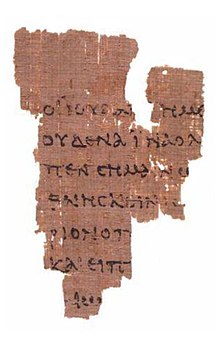
| Part of a series on |
| Books of the New Testament |
|---|
 |
| Part of a series of articles on |
| John in the Bible |
|---|
 |
| Johannine literature |
| Authorship |
| Related literature |
| See also |
The Gospel of John[a] (Ancient Greek: Εὐαγγέλιον κατὰ Ἰωάννην, romanized: Euangélion katà Iōánnēn) is the fourth of the New Testament's four canonical Gospels. It contains a highly schematic account of the ministry of Jesus, with seven "signs" culminating in the raising of Lazarus (foreshadowing the resurrection of Jesus) and seven "I am" discourses (concerned with issues of the church–synagogue debate at the time of composition)[3] culminating in Thomas's proclamation of the risen Jesus as "my Lord and my God".[4] The gospel's concluding verses set out its purpose, "that you may believe that Jesus is the Christ, the Son of God, and that believing you may have life in his name."[5][6]
John reached its final form around AD 90–110,[7] although it contains signs of origins dating back to AD 70 and possibly even earlier.[8] Like the three other gospels, it is anonymous, although it identifies an unnamed "disciple whom Jesus loved" as the source of its traditions.[9][10] It most likely arose within a "Johannine community",[11][12] and – as it is closely related in style and content to the three Johannine epistles – most scholars treat the four books, along with the Book of Revelation, as a single corpus of Johannine literature, albeit not by the same author.[13]
- ^ ESV Pew Bible. Wheaton, IL: Crossway. 2018. p. 886. ISBN 978-1-4335-6343-0. Archived from the original on 3 June 2021.
- ^ "Bible Book Abbreviations". Logos Bible Software. Archived from the original on 21 April 2022. Retrieved 21 April 2022.
- ^ Lindars 1990, p. 53.
- ^ Witherington 2004, p. 83.
- ^ Edwards 2015, p. 171.
- ^ Burkett 2002, p. 215.
- ^ Lincoln 2005, p. 18.
- ^ Hendricks 2007, p. 147.
- ^ Reddish 2011, pp. 13.
- ^ Burkett 2002, p. 214.
- ^ Reddish 2011, p. 41.
- ^ Bynum 2012, p. 15.
- ^ Harris 2006, p. 479.
Cite error: There are <ref group=lower-alpha> tags or {{efn}} templates on this page, but the references will not show without a {{reflist|group=lower-alpha}} template or {{notelist}} template (see the help page).